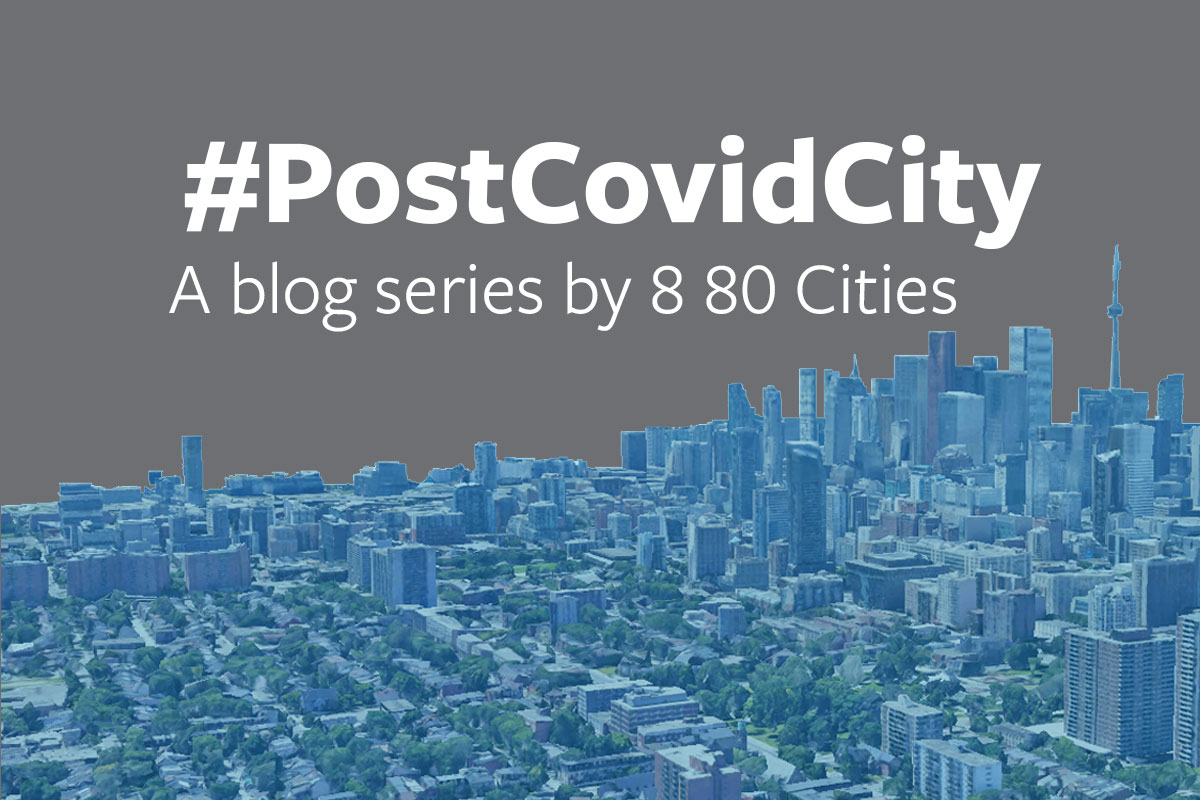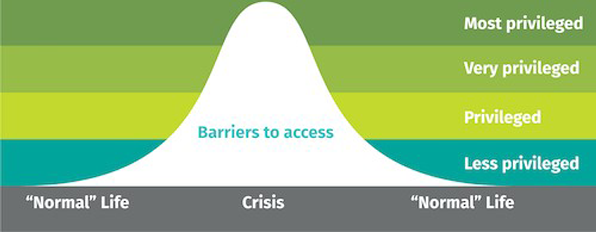
03 Jul #PostCovidCity: The Future of Community Engagement
By Brandon Miles, Summer Project Assistant
The Covid-19 pandemic has changed almost every aspect of society from the way we work to the way we play. It has projected a spotlight on the foundational cracks within our systems and has exposed the unjust, unsustainable, and inequitable structures of the modern societies that we live under throughout our day to day lives.
In the context of urban planning, this global pandemic has made us reassess how city-building practices are working and which ones are not, beginning with community engagement.
In it’s purest form, community engagement through an urbanist lens is defined as a process that brings members of a neighbourhood, community, or city together to spark more substantial involvement in city-building practices. It is a strategy to form and strengthen local bonds, bring together all members of society, and promote civic leadership. It is furthermore a process of gathering data to inform decision-makers of what their communities need.
Historically, most community engagement processes have involved in-person interaction to bring the local community together. But this has been a problem as cities remain shut down to avoid the spread of COVID-19. This has led to temporary alternatives to arise amid this pandemic that instead uses an array of electronic and online tools, surveys and conversations through social media platforms in order to keep the conversations going.
However, as adaptive as these solutions may be in our modernized world, these band-aid fixes have also created new barriers for community members from getting involved in city-building decisions. Yes, the internet has helped us make great strides in communication during this pandemic and it has allowed us to share online resources and engagement tools for those that seek it. Externally, it has allowed us to reach many audiences over great distances, including those with disabilities who may have faced barriers in accessing and contributing to in-person engagements. Internally, it has allowed us to gather data and information easily and effortlessly so that we may synthesize and understand what the voices of those communities are saying. Yet the question that needs to be posed is: who is now missing from the current community engagement processes we have undertaken? Who is the data for, how is it being analyzed, and who has access to it? Most importantly, who has this online process really helped out and who has it excluded?
Simply getting online is a privilege that not everyone has access to on equal terms. Those who can afford it have access to it, but those that can’t are pushed to the sidelines of community decision-making. Access to online tools via the internet can also be unstable or restricted in many regions of the world, and may further be a challenge to those that are digitally illiterate.
So in reality, those with economic privilege and are equipped with digital literacy will have their voices heard while many others will not. Simply put, people that are left out of these engagements are the critical pieces of the puzzle. Missing these key areas of data will only result in an incomplete picture. It is our job to seek out these underling narratives because, without them, we are only creating a world that benefits the few.

The image above represents how, during a crisis, access to participation may be out of everyone’s reach, but the most privileged will once again be the first to have their voices heard and interests represented once COVID-related barriers to participation are removed. Jacob Cramer – BC Healthy Communities
COVID-19 has raised an important challenge on how community engagement can adapt in a fast-paced and continuously changing world. As planners and urbanists alike, we are re-learning how to listen to and engage with all communities in order to make the right decisions in our cities. We must take action of our work by putting on a multi-disciplinary lens that focuses on equity and social justice, intersectional frameworks, and place-based stories.
We are learning to seek out the barriers that may arise out from our traditional practices of community engagement and address those issues head-on. We are learning to hand over the reins of control and only act as the conduits for communities to make change happen.
So this begs the question, how might we move forward with community engagement amid a Post-COVID world? How can community engagement change to the benefice of all people? How do we ensure we hear all the voices while adhering to the safety and wellbeing of others during these cautionary times?
It starts with equitable engagement, the design of new engagement tools, and the redesign of old tools that can give power to communities, allowing members to identify, voice, and address their challenges through tools that allow those communities to mitigate and shape their own futures. This Municipalities and organizations looking to employ equitable community engagement should consider such things as:
1. Reshaping your existing engagement toolbox
-
- It is important to first assess what you have at your fingertips and how these tools can be adapted or changed to allow for better engagement opportunities online and offline. Some engagement tools that may already be in use or have been used in times past may not work post-pandemic. Some engagement tools are also not equal in collecting data nor may they provide a full representation of voices. Putting on an intersectional and equity-based lens can help planners reassess what they have in their toolbox and reconfigure their methods to allow for all voices to be heard.
2. Developing engagement opportunities through a variety of platforms using both analog and digital tools
-
- While the internet is an excellent tool for engagement through platforms such as Zoom or Microsoft Teams, online engagement can also pose barriers for many groups that may not have the access or necessary tools to participate. Thinking of how to provide various forms of communication using a mix of digital and analog tools including through is key to equitable community engagement. Reverting back to the days of pre-paid postage or outreach through the telephone is great for those that may be digitally illiterate. Telephone Town Halls that allow you to connect into a city meeting with a simple call-in so that you can participate in town meetings is one way to provide engagement for those that may not be fully tech-savvy. Technological tools such as simulcasting or virtual engagements through webinars, live streams, or virtual Q&A periods with text support and video are other techniques that can be utilized to their fullest advantage for community engagement opportunities. Imagine being able to participate and engage in a City Hall deputation from the comfort of your own bed! On the digital end of things, another area of focus is to rethink how you may be sharing your social media to gather data and information or targeting stronger engagement practices to specific groups within these platforms. Not all social media platforms have equal audience representation.
- By providing a mix of analog and digital engagement methods while also providing other external supports such as pre-paid postage envelops can ensure your community engagement is equitable and safe for all people Post-COVID.
3. Mastering community outreach by meeting people where they’re at
-
- Become comfortable with planning outreach in order to provide convenience and safety for the communities that you want to get involved in the process. A simple strategy to increase access and spark community engagement is to connect with the places that people naturally gravitate towards. Depending on your targeted audience, meeting people where they are at can be approached through either a physical space, digital space, or both. Physical spaces can include under-represented neighbourhoods or communities with low engagement activity, whereas digital spaces for engagement can incorporate a range of online platforms such as Facebook, LinkedIn, or even TikTok which cater to a host of different audiences. With out-of-the-box thinking, urbanists can use platforms such as these as a springboard for innovation to instill a variety of community engagement.
4. Ensuring there is two-way communication between those with lived experience and civic knowledge and those with urban planning backgrounds
-
- Rather than bringing your knowledge to the table, approach engagement through active listening and an open mind around the issues that play out. Allow space for concerns and feedback while keeping up in continuous dialogue. Further, listen to those voices and believe what they are telling you. Taking a quote as place-maker Jay Pitter once stated, “every single site has dominant and subordinate narratives. It is our job to look for [those] subordinate voices.”
5. Allowing for and giving full authority to community-led initiatives in planning
-
- Working within the framework of the objectives of those that live in the community and bringing those communities into the forefront of the planning process.
- Ontario Together is one example of community-led leadership where the Province of Ontario has created a platform that allows for civic outreach while also seeling advice and solutions from community members in order to combat COVID-19.
6. Continuing to maintain relationships and build trust among community members
-
- Constant communication with community members is key before, during, and after any and all engagement events. Connecting and establishing relationships with community members will form the groundwork for any future engagements. Actively including community members into ongoing engagements and city-building processes are key to understanding what those in the community actually need rather than what we may think they want. Following up with community members after an event has passed over short, medium, and long-term periods of time will solidify and maintain any community relationships that may have been built through this community engagement process. Getting to know people one-on-one will help build trust and form new bonds.
7. By putting on the 8 80 Lens
-
- Use multiple frames of perspective, including groups aged 8 or 80, groups who are Black, Indigenous or racialized, and groups with different abilities, different genders, and different socioeconomic statuses. Having an intersectional lens will ensure that community engagement is equitable.
City-building comes from the ground up where people live and where communities are created. It is through these pre-emptive forms of community engagement that we can build cities in a just and equitable manner. It is our job as urbanists to listen to, adhere to, and take action in what all of our communities are voicing and work to provide our communities with an assortment of accessible engagement options. Only then can we get the full picture of what our communities need.
As we continue on this COVID-19 journey together, we must continue to constantly reassess how we provide fair engagement during and after this pandemic has passed. Through an intersectional and equity-based lens, we must redesign the conventional ways of thinking and provide new unconventional ways of engaging with others. We must provide a stronger array of mixed engagement opportunities with barrier-free access using both digital and analog tools. While also balancing and redistributing power in the field of planning.
Finally, we must ensure that there is a full representation of voices within all the work that we do, and prioritize those that may not be heard. As we enter into a post-pandemic world, the path that we choose to take going forward in city-building will depend on the decisions that we make now with the types of community engagement methods we posses already, the ones that we partake in with others, and the ones that may be unconventional to mainstream engagement.



